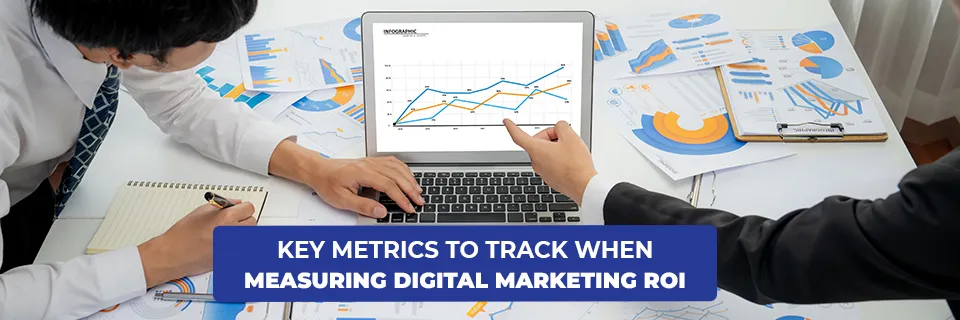
Published Date: 15 Jul 2025
Client acquisition can be challenging, but with the right strategy, it becomes a streamlined process. Key steps include investing in targeted digital marketing, allocating time and resources effectively, and consistently measuring ROI to ensure meaningful returns. By focusing on data-driven decisions, businesses can optimize their efforts and achieve sustainable growth.
If you aren’t tracking the right metrics, you’re essentially operating in the dark, no matter how attractive your campaigns look or how many likes you receive.
That’s why it's essential to have strong marketing ROI metrics in place. These metrics go beyond surface-level engagement and show the real impact of your digital marketing campaigns.
Why Tracking ROI in Digital Marketing Matters
Understanding your digital marketing ROI isn't just about proving that your budget is wisely allocated. It also results in better decisions for improved campaigns. Plus, it helps us understand what really drives growth. In an age of data, focus on what matters. Dismiss vanity metrics; focus on conversions, revenue, and cost efficiency.
1. Customer Acquisition Cost (CAC)
CAC tells you how much you’re spending to acquire a single customer. It’s a simple yet key metric for marketing analytics. It helps us understand profitability.
Formula: CAC = Total Marketing Spend / Number of New Customers
If your CAC is higher than your average customer’s lifetime value, you’re losing money—plain and simple.
2. Campaign Conversion Tracking
Campaign conversion tracking shows what your audience does. This includes actions like submitting lead forms, making e-commerce purchases, or downloading apps. Without this, it’s impossible to tie performance back to specific efforts.
Good digital marketing KPIs in this area include:
• Conversion Rate
• Cost per Conversion
• Bounce Rate on landing pages
These help you assess campaign effectiveness and tweak underperforming strategies.
3. Return on Ad Spend (ROAS)
ROAS is a core part of campaign ROI tracking. It measures how much revenue you earn for every dollar spent on advertising. It’s not the same as total ROI, but it gives a clear snapshot of ad performance.
Formula: ROAS = Revenue from Ads / Cost of Ads
ROAS helps compare ad platforms, channels, and creative effectiveness.
4. Marketing Qualified Leads (MQLs) and Sales Qualified Leads (SQLs)
Getting traffic is one thing. But not all leads are created equal. Tracking how many MQLs and SQLs each campaign generates helps with campaign ROI analysis and tells you which efforts are attracting the right people.
This metric connects marketing and sales. It makes your marketing ROI report more useful for both teams.
5. Lead-to-Customer Rate
If you're bringing in hundreds of leads that never convert, that’s wasted potential. Track how many leads become paying customers in your digital marketing analytics.
This rate helps you:
• dentify weak spots in the sales funnel
• Forecast revenue more accurately
• Optimize messaging to move people down the funnel
6. Website Engagement Metrics
Web behavior is important, even if it doesn't lead to sales right away. For example, average session duration, pages per session, and returning visitor percentage all show how engaging your content is.
These metrics show how well your campaigns perform. They also provide useful conversion data.
7. Attribution Modeling
Not all conversions happen with one click. Users often interact with your brand several times before deciding. This is where ROI tracking methods like attribution modeling are useful.
You can choose between:
• First-touch attribution (the first interaction gets credit)
• Last-touch attribution (the final interaction gets credit)
• Multi-touch attribution (credits all touchpoints)
This shows you which parts of your strategy work together for results.
8. ROI Reporting Tools
The integrity of accurate data is greatly influenced by the choice of tools. Some ROI tools that show results are Google Analytics, HubSpot, and custom dashboards.
They provide real-time data. These also aid in the automation of reporting while keeping blind spots in terms of data at bay.
You do not need to have dozens of platforms; only a proper mix is necessary to track what matters the most.
Final Thoughts
The ROI is not a figure; instead, it is the narrative your data explains about your marketing efforts. The right metrics help you better understand marketing ROI. They provide deeper and different insights. You will form better strategies and utilize your marketing budget wisely.
Combine different KPIs in digital marketing. Focus on CAC, ROAS, conversion rates, and attribution modeling. This way, your business will be able to identify what works and drop what doesn't.
Twenty-Four Seven Consultancy Get data-driven results with ROI-focused digital marketing. We use smart strategies and real-time data to help your brand grow easily, not with extra effort.
FAQs
Q: What’s a good ROI for digital marketing?
A: There are industry variations, but a widely accepted mark is a 5:1 ratio: $5 earned for each $1 spent. Nonetheless, high-performing campaigns may reach a 10:1 ratio or better.
Q: Can I calculate marketing ROI without revenue data?
You can think about lead value or engagement goals. But, you need revenue data to calculate real ROI.
Q: How often should I track digital marketing ROI?
A: Most businesses should check monthly. For active campaigns needing quick changes, check weekly.
Q: What’s the difference between ROAS and ROI?
A: ROAS looks at the return from ad spending and revenue. ROI, on the other hand, considers all marketing costs. This includes salaries, tools, and content production expenses.
Recent Posts
Categories
Blog Author